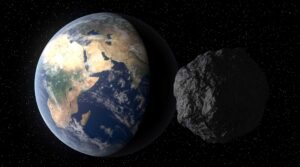In early 2025, asteroid 2024 YR4 gained prominence in the news due to a small probability of reach the earth within seven years. Since then, scientists constantly monitor this object and adjust their calculations to better understand the risk it pursues.
This space rock, about 60 meters in diameter, size equivalent to that of a 20 -story building, was discovered in December last year and, in early January, its chance of colliding with Earth in 2032 was just larger than 1%. This means that of 100 possible simulations of its trajectory, in one asteroid collided with our planet – a low risk, but still caused concern.
Over time, the data collected allowed experts to review these numbers several times. In mid -February, this chance even rose to 3.1%but soon after it began to fall, reaching almost insignificant levels in June, less than 0.0000081%. That is, the chance of an impact has virtually disappeared as the data became more accurate.
Interestingly, while the possibility of a collision with the earth diminished, it increased the risk to the moon. In February, this probability was 1.7% and reached 4.3% in June. If this happens, ejected pieces of impact could reach the earth, but most would burn in our atmosphere without damaging.
How do scientists measure the chances of impact of an asteroid?
In an article published on the website The Conversationscientist Toshi Hirabayashi, an aerospace engineering professor at the Georgia Institute of Technology in the US, explains that to find out if an asteroid can hit Earth, researchers study their orbit using a technique called astrometry.
According to Hirabayashi, this technique measures the position of the object very accurately, allowing to calculate its path through the space with a small margin of error (only a few kilometers).
Even so, it is not possible to trace an accurate path right away. The first measurements generate a cloud of possible trajectories, which form an area called the “error ellipse”. Within this area, some of these routes can lead to Earth, some not.
In the beginning, this ellipse is usually great, with great uncertainty. This can make the Earth appear to be within the risk area, even if the central trajectory of the asteroid is far from the planet. With more observations, the ellipse decreases and becoming more accurate.
“So when the earth is within a small error ellipse, the likelihood of impact can be greater than when it is inside a large error ellipse,” explains Hirabayashi. On the other hand, if the ellipse shins and leaves the planet out of it, the risk drops a lot – as happened with the 2024 YR4.
Read more:
Communication should be as clear as possible
Although the initial chance of asteroid collision 2024 YR4 has worried, the constant variation in numbers and the use of technical terms caused doubts among the public. Many did not understand what values really meant, which generated insecurity and even fear.
Therefore, experts reflect on the best way to inform the public in such cases. For Hirabayashi, just presenting the chance of impact may not be enough. It is important to show the context, explain uncertainties and what happens as new information comes.
Some suggestions from the scientist are to wait for more data before disclosing numbers, or create indicators that help to better evaluate the threat of an impact. Thus, the public receives clear information, without causing panic, and better understands what is happening in space.











